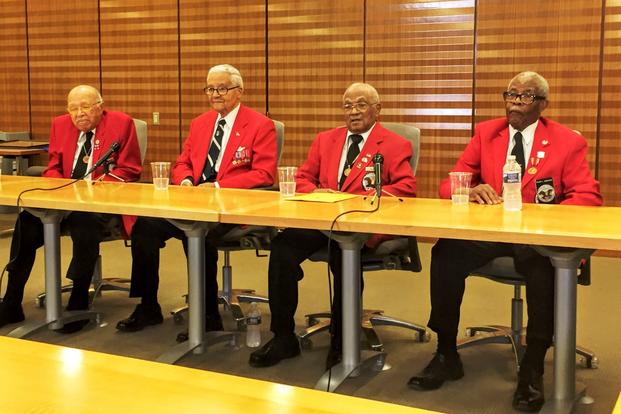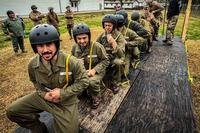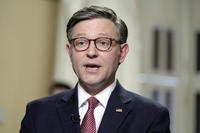As they sat around a table wearing crisp, red jackets in honor of their famed unit's red-tailed aircraft, four Tuskegee Airmen recounted war stories as if they happened yesterday.
They were among the men who defied the odds by becoming the first African-American pilots, navigators and support personnel to serve during World War II, often escorting and protecting bombers.
Retired Col. Charles McGee, former cadets Walter Robinson and William Fauntroy Jr., all trained as pilots, and former Pvt. Major Anderson, a maintainer, joined the Army Air Corps and ended up in Tuskegee, Ala., in front of leaders who "found ways to bring necessary training to us who were totally segregated," Robinson said.
The veterans, who range in age from early-to-late 90s, sat down with reporters at an event hosted by the Air Force Academy Society on May 17 in Washington, D.C.
McGee, an ROTC student at the University of Illinois who joined the Army in 1942, said there were a few phases to "the Tuskegee experience."
'The Tuskegee Experience'
He described the activation of the 99th Fighter Squadron, the first Tuskegee unit to deploy in 1943 to Northern Africa, flying the P-40 Warhawk.
The next phase extended the mission to the larger 332nd Fighter Group, bringing in additional squadrons flying P-39 Airacobras, P-47 Thunderbolts, and P-51 Mustangs -- identified by their famous "red tails." The markings flagged to counterparts the pilots were friendlies and earned the airmen their nickname.
Then came the activation of the 477th Bombardment Group, which trained on B-25 Mitchell bombers in the U.S. but did not complete training in time to see combat.
The effort brought together 996 pilots, and more than 15,000 maintenance, ground and support personnel, leading to 1,491 combat missions, according to the Air Force Historical Research Agency.
"They didn't drop the standards [for us], even though they didn't think we were going to be successful," said McGee, reflecting on his time as a first lieutenant.
"We were trained well, we were prepared for the opportunities, and although we were segregated ... fortunately the record that we established helped the Air Force when they separated from the Army ... to say, 'We need to integrate.'"
'The Man That Taught All of Us'
As an institution, the Army didn't change its attitude toward African-Americans during World War II, even as the Tuskegee Airmen began training, McGee said. Rather, the unit's leaders -- men like C. Alfred Anderson -- made the training worthwhile, he said.
Anderson, a pioneer black aviator and first chief civilian flight instructor at the Tuskegee Institute, worked to make them exceptional.
"I give all the credit to those guys," Fauntroy said of the instructors who made him feel like "I was capable of going into combat."
Fauntroy, "the baby in the bunch," signed up with the Army Reserve in 1944 at 17 years old. But the war ended before he got the chance to deploy. He said if it weren't for the instructor pilots, the airmen would never have become aviators.
Anderson would become "the man that taught all of us," Fauntroy said.
Their training was enhanced when combat veterans came back from the war and continued practicing with them on lessons learned while over German skies.
While attending Howard University in Washington, D.C., in 1941, Robinson volunteered for the Army Air Corps. Although he too didn't get his chance to serve in combat, he said, "It has to be noted, that there are those who brought to the Tuskegee experience an intelligence of training and protection that we wouldn't have been able to survive without."
'In My Gun Sights'
McGee did get the chance to see action overseas.
On Aug. 24, 1944, he was escorting B-17 Flying Fortresses from the 5th Bomb Wing over Czechoslovakia when a group of German Luftwaffe fighters came roaring in.
The "fighters tried to penetrate the bombers we were escorting, and my element was designated to chase them off," he said
"[The enemy fighter] took a dive for the ground and, fortunately, I was behind him. He made a turn that put him right in my gun sights. And that was it."
McGee flew 409 fighter combat missions in World War II, Korea and Vietnam.
'Love Your Mechanic'
Major Anderson was only 16 when the U.S. entered the war in 1941. He registered for the draft at 18 and was called up a few months later. He served as a mechanic.
"If you didn't love your mechanic, you didn't understand what he was doing for you," Robinson said of Anderson. The ground personnel worked tirelessly to keep the airmen safe, he said.
After basic training and about five months of occupational school, Anderson found himself stateside in 1944 patching up B-25s riddled with bullet holes as a sheet metal repairman with the 477th Bombardment Group. He was honorably discharged in 1946.
"And that's my story," he said.
For him, the experience was routine -- like the other men, he was just doing his job.
'Doing Something for Your Country'
McGee agreed.
"It came from the basis of doing something for our country -- for me, doing something I liked, knowing that's what I'd pass on to young people now," he said.
McGee said he fears technological advancements may be taking skilled jobs away from workers. He also said the U.S. must work to improve its schools so young people can prepare for today's fast-paced work culture and be granted opportunities previously unavailable to them.
The same goes for the U.S. service branches, McGee said.
"Sometimes, you have to focus specifically," he said. "If the problem is more minorities and more women in, then there should be a focus of training more minorities and women to fill whatever that job is."
He added, "It's got to start before they're 18, and we need to pay attention to that if we're going to improve the future, that all are represented equally in whatever endeavoring field."
'American Opportunity'
Looking back, the men said they had no regrets for choosing military service.
The Army Air Corps became the Air Force in 1947. A year later, President Harry S. Truman signed the executive order to begin desegregation throughout the armed forces.
"Segregation was wrong, but looking back at that time ... we established lifelong friendships," McGee said. "Much of the story gets lost in Air Force history, but we're still proud we were able to serve our own country."
At the end of the discussion, the message was clear: Keep breaking barriers.
"We accomplished something that helped lead the country," McGee said. "We didn't call this civil rights. It was American opportunity."
-- Oriana Pawlyk can be reached at oriana.pawlyk@military.com. Follow her on Twitter at @Oriana0214.
Related Video:






























